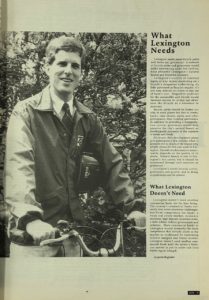WHAT LEXINGTON NEEDS, by Layton Register
May 1991 Ace
Lexington needs more bicycle paths and, better yet, greenways. A network of bicycle paths and greenways would make commuting safer for cyclists, help preserve Lexington’s natural beauty and boost the economy.
 Lexington’s scarcity of reserved rights of way makes commuting on a bicycle a dangerous undertaking. As little pavement as bicycles require, it’s still very difficult for riders to stay out of harm’s way. Respective roadways for the automobile and bicycle would decrease injuries to cyclists and eliminate the bicycle as a nuisance to motorists.
Lexington’s scarcity of reserved rights of way makes commuting on a bicycle a dangerous undertaking. As little pavement as bicycles require, it’s still very difficult for riders to stay out of harm’s way. Respective roadways for the automobile and bicycle would decrease injuries to cyclists and eliminate the bicycle as a nuisance to motorists.
Bicycle paths should be linked not only to work places but also to creeks, banks, lake shores, parks and other greenspaces, thus creating greenways. In addition to providing a transportation system, greenways would help preserve the city’s natural beauty as development proceeds at the expense of farms and fields.
It’s ironic that development plans give greenspace a low priority when it accounts for so much of the reason why people choose to live and work in Lexington. Growth of a business or municipality depends on the quality of its assets. Natural beauty is one of Lexington’s key assets, but it should be maintained through such measures as greenways.
Lexington needs bicycle safety, greenspace and growth, and in doing so greenways are the answer.
What Lexington Doesn’t Need
 Lexington doesn’t need another commercial bank, for the time being. The country’s commercial banks currently face some enormous challenges: non-bank competition for funds, a weak real estate market, economic recession, high deposit insurance costs, a debt ridden federal government and inflation. More commercial banks in Lexington would intensify the keen competition that already exists in the market as evidenced by the narrowing interest margins and lower income. Lexington doesn’t need another commercial bank until the nation’s financial system is put in order and local banks regain strength.
Lexington doesn’t need another commercial bank, for the time being. The country’s commercial banks currently face some enormous challenges: non-bank competition for funds, a weak real estate market, economic recession, high deposit insurance costs, a debt ridden federal government and inflation. More commercial banks in Lexington would intensify the keen competition that already exists in the market as evidenced by the narrowing interest margins and lower income. Lexington doesn’t need another commercial bank until the nation’s financial system is put in order and local banks regain strength.








